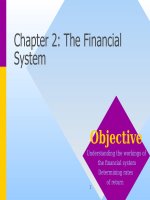Introduc corporate finance ch13
Bạn đang xem bản rút gọn của tài liệu. Xem và tải ngay bản đầy đủ của tài liệu tại đây (390.35 KB, 35 trang )
Chapter 13: Corporate Financing
Decisions and Efficient Capital
Markets
13.1 Can Financing Decisions Create Value?
13.2 A Description of Efficient Capital Markets
13.3 The Different Types of Efficiency
13.4 The Evidence
13.5 Implications for Corporate Finance
13.6 Summary and Conclusions
13.1 Can Financing Decisions
Create Value?
Earlier parts of the book show how to
evaluate investment projects according
the NPV criterion.
The next five chapters concern financing
decisions.
What Sort of Financing
Decisions?
Typical financing decisions include:
How much debt and equity to sell
When (or if) to pay dividends
When to sell debt and equity
Just as we can use NPV criteria to
evaluate investment decisions, we can
use NPV to evaluate financing
decisions.
How to Create Value through
Financing
1.
Fool Investors
•
2.
Reduce Costs or Increase Subsidies
•
3.
Empirical evidence suggests that it is hard to fool
investors consistently.
Certain forms of financing have tax advantages or
carry other subsidies.
Create a New Security
•
•
Sometimes a firm can find a previously-unsatisfied
clientele and issue new securities at favorable prices.
In the long-run, this value creation is relatively small,
however.
A Description of Efficient Capital
Markets
An efficient capital market is one in which
stock
prices
fully
reflect
available
information.
The EMH has implications for investors and
firms.
Since information is reflected in security prices quickly,
knowing information when it is released does an investor
no good.
Firms should expect to receive the fair value for securities
that they sell. Firms cannot profit from fooling investors in
an efficient market.
Reaction of Stock Price to New
Information in Efficient and Inefficient
Markets
Stock
Price
Overreaction to “good
news” with reversion
Delayed
response to
“good news”
Efficient market
response to “good news”
-30
-20
-10
0
+10
+20
+30
Days before (-) and
after (+)
announcement
Reaction of Stock Price to New
Information in Efficient and Inefficient
Markets Efficient market
Stock
Price
Delayed
response to
“bad news”
response to “bad news”
-30
-20
-10
Overreaction to “bad
news” with reversion
0
+10
+20
+30
Days before (-) and
after (+)
announcement
The Different Types of
Efficiency
Weak Form
Semi-Strong Form
Security prices reflect all information found in past
prices and volume.
Security prices
information.
reflect
all
publicly
available
Strong Form
Security prices reflect all information—public and
private.
Weak Form Market Efficiency
Security prices reflect all information found in
past prices and volume.
If the weak form of market efficiency holds,
then technical analysis is of no value.
Often weak-form efficiency is represented as
Pt = Pt-1 + Expected return + random error
t
Since stock prices only respond to new
information, which by definition arrives
randomly, stock prices are said to follow a
random walk.
Stock Price
Why Technical Analysis Fails
Investor behavior tends to eliminate any profit
opportunity associated with stock price patterns.
Sell
Sell
Buy
Buy
If it were possible to make
big money simply by
finding “the pattern” in the
stock price movements,
everyone would do it and
the profits would be
competed away.
Time
Getting Technical
Barron’s March 5, 2003
Getting Technical
Back to Buy Low, Sell High
March 12, 2003
Barron’s
Getting Technical, continued.
Most technical indicators fall into two categories -- trend
followers and overbought/oversold oscillators.
The former include such tools as moving averages and pattern
breakouts. The latter include such tools as the relative strength
index and stochastics. All of them work great when used as
designed. The problem is that most people simply apply them all
the time, and that can cause problems.
For example, if moving averages are trend-following tools that
signal a change in trend when prices cross them, what happens
when there's no trend?
If we apply the commonly used 50-day moving average and
prices have been in a trading range for six months, it's not
uncommon for the market to cross the average many times in
both directions. The result is a series of losses.
So, there's nothing wrong with the tool; it's just the wrong one to
use under the circumstances.
Getting Technical, continued
Clearly, the bull market is over. Arguably, the bear market is over,
too. We can't be sure of that until more time passes.
I believe it ended last July. During that market bottom, we saw a big
rush to the exits in the form of a big price decline and reversal -- as
well as the biggest volume on record except for the postSeptember 11 period.
And even though the major market indexes made lower lows in
October, it wasn't by much. There was neither a significantly
lower low nor a significantly lower high. The classic definition of
a declining trend was not met, so the bear market was broken.
Even if the market undercuts those lows once again, that alone
would not a bear market make. A bearish signal would come only if
the market cannot trade back up to its range top in the next cycle. A
lower low and a lower high would mark a new bearish trend.
…the end of a bear market doesn't necessarily lead directly to a
new bull market. Conditions are now ripe for a 1970s-style, decadesized flat market (see chart 1). Sure, we could hit a new low here,
but I don't believe it will be a significantly lower low.
Semi-Strong
Efficiency
Form
Market
Security Prices reflect all publicly
available information.
Publicly available information includes:
Historical price and volume information
Published accounting statements.
Information found in annual reports.
Strong Form Market Efficiency
Security Prices reflect all information—
public and private.
Strong form efficiency incorporates weak
and semi-strong form efficiency.
Strong form efficiency says that anything
pertinent to the stock and known to at
least
one
investor
is
already
incorporated into the security’s price.
Relationship among Three Different
Information Sets
All information
relevant to a stock
Information set
of publicly available
information
Information
set of
past prices
Some Common
Misconceptions
Much of the criticism of the EMH has
been based on a misunderstanding of
the hypothesis says and does not say.
What the EMH Does and Does NOT
Say
Investors can throw darts to select stocks.
This is almost, but not quite, true.
An investor must still decide how risky a portfolio he
wants based on risk aversion and the level of
expected return.
Prices are random or uncaused.
Prices reflect information.
The price CHANGE is driven by new information,
which by definition arrives randomly.
Therefore, financial managers cannot “time” stock and
bond sales.
The Evidence
The record on the EMH is extensive,
and in large measure it is reassuring to
advocates of the efficiency of markets.
Studies fall into three broad categories:
1.
2.
3.
Are changes in stock prices random? Are there
profitable “trading rules”?
Event studies: does the market quickly and
accurately respond to new information?
The record of professionally managed investment
firms.
Are Changes in Stock Prices
Random?
Can we really tell?
A matter of degree
Many psychologists and statisticians believe that
most people want to see patterns even when faced
with pure randomness.
People claiming to see patterns in stock price
movements are probably seeing optical illusions.
Even if we can spot patterns, we need to have
returns that beat our transactions costs.
Random stock price changes support
weak-form efficiency.
What Pattern Do You See?
With different patterns, you may believe that you can predict the next value
in the series—even though you know it is random.
Event Studies: How Tests Are
Structured
•
Event Studies are one type of test of the semistrong form of market efficiency.
•
•
This form of the EMH implies that prices should reflect
all publicly available information.
To test this, event studies examine prices and
returns over time—particularly around the arrival
of new information.
Test for evidence of under reaction,
overreaction, early reaction, delayed reaction
around the event.
How Tests Are Structured
(cont.)
Returns are adjusted to determine if they are
abnormal by taking into account what the rest of
the market did that day.
The Abnormal Return on a given stock for a
particular day can be calculated by subtracting
the market’s return on the same day (RM) from the
actual return (R) on the stock for that day:
AR= R – RM
The abnormal return can be calculated using the
Market Model approach:
AR= R – (α + βRM)
Cumulative abnormal returns
(%)
Event Studies: Dividend
Omissions
Cumulative Abnormal Returns for Companies Announcing
Dividend Omissions
1
0.146 0.108
-8
-6
0.032
-4
-0.72
0
-0.244
-2 -0.483 0
-1
2
4
6
8
Efficient market
response to “bad news”
-2
-3
-3.619
-4
-5
-4.563-4.747-4.685-4.49
-4.898
-5.015
-5.183
-5.411
-6
Days relative to announcement of dividend omission
S.H. Szewczyk, G.P. Tsetsekos, and Z. Santout “Do Dividend Omissions Signal Future Earnings or Past Earnings?” Journal
of Investing (Spring 1997)









